No CrossRef data available.
Article contents
Visual Resources: an international journal of documentation, edited by Helene E. Roberts. New York, London, Paris, Montreux, Tokyo: Gordon and Breach Science Publishers. Four issues per volume. Corporate subscription rate per volume: $120. Individual subscription rate per volume: $80. ISSN 0197-3762.
Published online by Cambridge University Press: 06 June 2016
Abstract
An abstract is not available for this content so a preview has been provided. Please use the Get access link above for information on how to access this content.

- Type
- Reviews
- Information
- Copyright
- Copyright © The Art Libraries Society 1988
References
1. For whose course in Photographic Archives (LS 471, Spring 1987) at Simmons College Graduate School of Library and Information Science, and constant encouragement I am very grateful. Linda Watkins, Elizabeth Donnelly, and Ilze Olmsted of the Simmons College Libraries all provided gracious help, for which I heartily thank them.Google Scholar
2. The second issue (v.l, no.2,3, Fall
1980/Winter
1981, p.122) focused on prehistoric and ancient art, while the third (v.2, no. 1,2,3, Fall/Winter
1981/Spring
1982, p.2) concentrated on sources for the photographic documentation of Roman and Etruscan art. The last issue (v.3, no.l, August 1983) had no editorial. The first three issues were published by Iconographic Publications, the fourth and final number of the first run was published by Gordon and Breach.Google Scholar
4. Respectively, Spring
1980: 67–73; Fall
1980/Winter
1981: 173–187, and 193–199; Fall/Winter
1981/Spring
1982: 7–17 and 68–91; and August 1983: p. 50–60.Google Scholar
5. Such as James, D. L., “The Archive for Research in Archetypal Symbolism”, and Samuel, E., “The Illustrated Bartsch: Approaches to the Organization of Visual Materials”, Spring
1980: p.7-18 and p.60–66, respectively. Another article of great appeal for art historians especially is C. Thompson’s “Why Do You Need to See the Original Painting Anyway?” (Fall/Winter 1981/Spring
1982: p.21–36).Google Scholar
6. For Markey’s article see Visual Resources, August 1983: p. 16–49. Another intriguing article that seems wrong for Visual Resources is Hoffberg’s, J. “Microfiche Art: Interview with Caroline Kent (Fall/Winter 1981/Spring 1982: p.92-100)”, because it concerns an artist’s use of microfiche to create works of art, not reproduce them.CrossRefGoogle Scholar
7. The Visual Resources Association (VRA) is an organization of visual resources administrators in the broadest sense. Founded in 1983, it conducts conferences, workshops, and tours, and publishes a quarterly newsletter, the International Bulletin for Photographic Documentation of the Visual Arts, in addition to the new series of the Slide Buyer’s Guide (Sundt, C. L., “Introduction. Visual Resources and the Visual Resources Association”, Visual Resources, New Series, III, no.2, Summer
1986: p.5–6).Google Scholar
8.
Roberts, Helene E.
very kindly provided most of this information during an interview of September 14, 1987.Google Scholar
11.
Summer
1986: p.75–96 and p.107–116; Autumn
1986: p.167–184; Winter
1987: p.263–271; and Spring
1987: p. 1–24, and p.51–70, respectively.Google Scholar
12.
Summer
1986:p.97–105; Autumn
1986:p.185–208 and p.209–226; Winter
1987: p.287–315; Spring
1987: p.25–49 and p.71–82; and Summer
1987: p.141–151, respectively.Google Scholar
14. The problem certainly goes much deeper. Like other international journals, Visual Resources permits writers to use the spelling of their country; many very common words therefore appear in different ways in one issue. How can international Authority Files be established when no one can agree about the spelling of such words as “organize” and “civilization”?Google Scholar
15. Ness (p. 181–182) gets very close to pin-pointing the reason why Boston is called “the Hub”, without actually finding an early 18th-century instance of this nickname. Residents today know, of course, that Boston is the Hub of the Universe.Google Scholar
16.
Alexander, J., Summer
1987: p. 165–174, and Hoort, R. J., ibid., p. 191–200, respectively.Google Scholar


